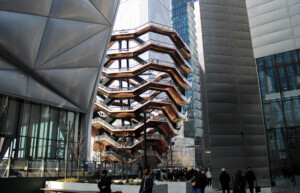In early October, New York Magazine’s senior art critic Jerry Saltz complained on Instagram that New York City “has been made to look like Houston or Atlanta or Charlotte or Milwaukee.” The object of his vitriol was Hudson Yards; in his post (technically, a repost of a photograph by New Yorker illustrator Roz Chast), the 28-acre complex on Manhattan’s Far West Side is seen from across the Hudson River, the Vessel sitting at the foot of adjoining skyscrapers like a discarded toy. “In the future I will organize Nuremberg-like trials of 98.9% of all architects,” Saltz wrote, before concluding with a direct appeal: “ALL ARCHITECTURE critics should be writing to stop or at least attack this everyday [sic]. Even if it’s hopeless. Don’t et [sic] them keep making this our city of ruins.”
Saltz is known for being kooky—I will never forget his series of social media posts, early in the pandemic, detailing his habit of buying several orders of large coffees at gas stations and delis, taking them home, putting them in the fridge, and reheating them throughout the week, nor his doubling-down when people questioned the practice, his claim being that making coffee at home amounted to snobbery—but I found this take particularly over-the-top. What, possibly, can critics do to stop developments like Hudson Yards from going up in New York City or anywhere else?
Most architecture criticism is done in the same mode as literary—or art, or music, or film—criticism: Buildings (as paintings or sculptures or records of movies) are taken as faits accomplis, fodder for admiration or derision, yet ultimately unchangeable. But unlike readers of literature, who can choose which authors to pay attention to and which to ignore, which books to buy and which to leave behind, users of architecture rarely get to decide whether or not they will interact with a particular building. For a reader, a piece of criticism is a useful tool. It can help them figure out how to intellectually approach a piece of writing; it can help them think about something after they’ve read it, or put it in conversation with something else; it can, simply, help them decide whether or not to buy a book.
Architecture is, with very few exceptions, not directly “consumed” in this way. Most people don’t approach architecture the way they do a book or a movie, with the explicit intention of consuming it directly. Most people spend time in a building because they’re there to do something else. Someone might never go out of their way to visit Hudson Yards, but they might see it regularly during their commute or in images online. Generally, people don’t get to choose what buildings they do or don’t interact with, unless they have a particular interest in visiting certain works of architecture; yet even that interest must pale in comparison to the hundreds or thousands of buildings people will experience over a lifetime, especially if they live in a city. Someone could choose to never read a piece of literature in their lives, but it would be impossible to never interact with a building.
It follows, then, that architecture criticism would differ significantly from literary criticism, that it would aim its missives at those who interact with buildings regularly—that is, everyone—as opposed to those already within the field or with a rarefied interest in it.
This isn’t the case. When it comes to audience, architecture criticism considers its readers to be a narrow set of specialists or, at least, hobbyists. The building is up, construction is done; now it’s time for someone who knows a bit about something to tell whoever might be paying attention what they think and, in the best of cases, invite them to formulate an opinion or two of their own.
This is fine for an audience interested in architecture as a subject and in the advancement of architectural ideas through building. But I don’t think this is the way most people think about architecture. We can take Saltz’s post, wherein architecture is singled out for its ability to define the identity of a city, as an example, but we don’t even have to look that far. I would be willing to bet that you, if you are in any way involved in the architecture field, have had to answer queries from friends or family members about why certain buildings—in particular contemporary buildings—look the way they do.
It’s hard to answer these questions with ideas we might find floating around architecture schools or in typical pieces of architecture criticism. After all, who really cares if a building is advancing some sort of theoretical architectural idea if that idea looks bad? It’s also hard to answer these questions with the truth—that some developer wanted to invest in real estate in a way that would send a signal to other capitalists that they are worth doing business with, or that might make them look “cool,” or both, that architecture, for the most part, is not made with the intention of protecting or advancing some sort of civic identity but rather with the goal of making a lot of profit for a few people—because the truth makes us feel like there’s not that much we can do about it.
That isn’t totally false. Saltz’s Nuremberg-like trials will take more than architecture critics “writing to stop or at least attack” some of the hideous things that are being built in cities right now. The things that get made will only change when the system of financing buildings changes from being led by for-profit private developers to public entities. That’s going to take huge reforms that will have to be won through political organization, not only of architectural workers but of all kinds of workers inside and outside the field.
Critics will not single-handedly bring about that change. But if we take advantage of the editorial freedom that the new proliferation of publishing platforms grants us, we just might change the mode of criticism from one that simply tacks on a fallow opinion to buildings that are already made, to one that looks closely at why and how buildings get made. We might become less interested in what a building looks like or how it engages with cutting-edge architectural ideas and more so in who paid for it or who gets to use it. We might try to find an audience that reaches beyond those already participating or interested in the field. We might draw clearer lines between those who see architecture as a speculative profit-making object and those who know it to be a source of civic pride, of cultural identity, of a feeling of home. We might, if we dare, make it just a bit easier for those who want to rage against the machine to do so.
Marianela D’Aprile is a writer living in Brooklyn. Her work on architecture, politics, and culture has appeared in Metropolis, Jacobin, ICON, The Nation, AN, and elsewhere. She sits on the board of The Architecture Lobby and is a member of the Democratic Socialists of America.











